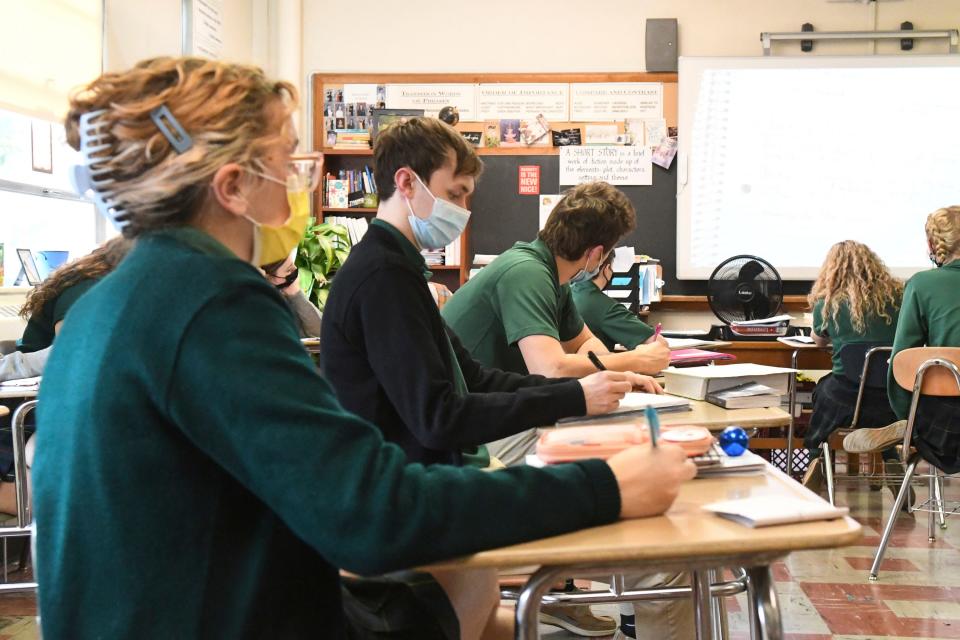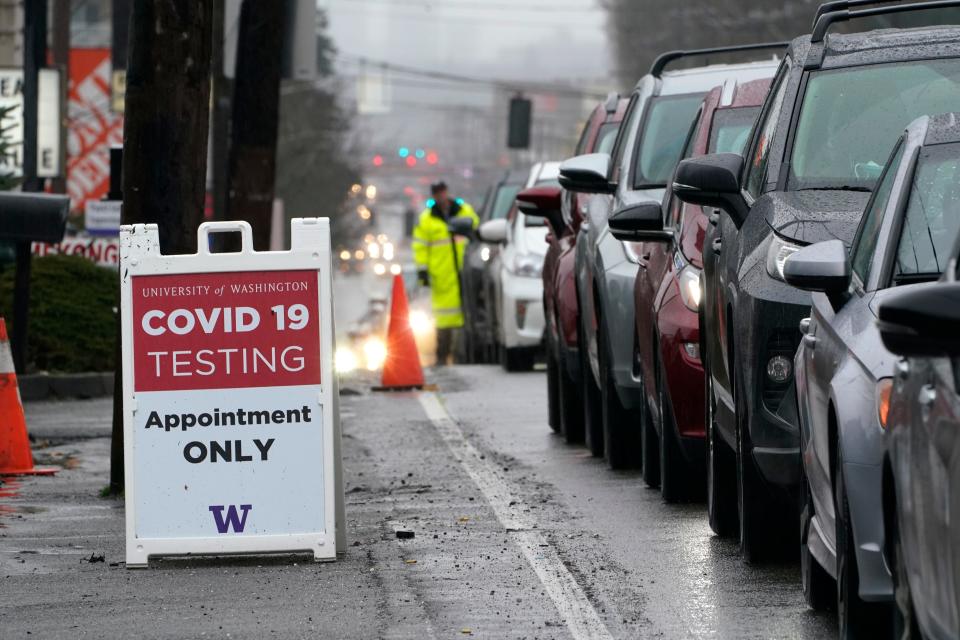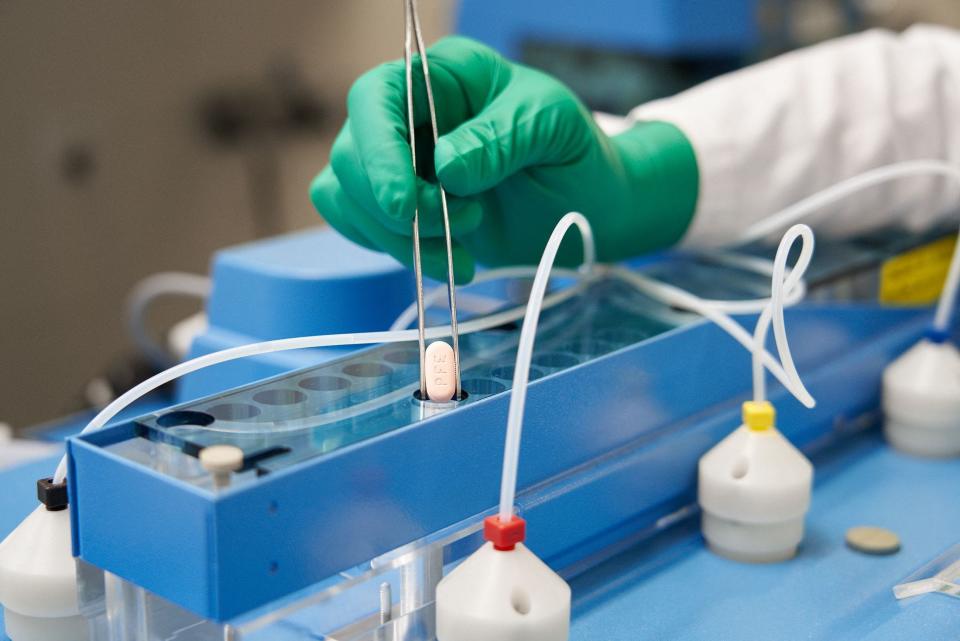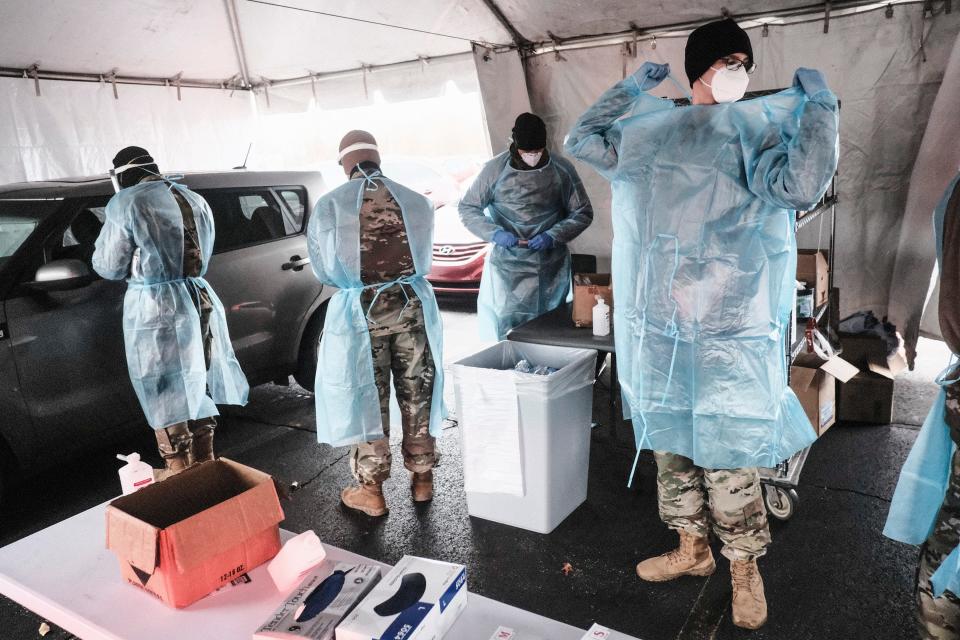The pandemic is changing. Will omicron bring a 'new normal' for COVID-19?
- Oops!Something went wrong.Please try again later.
- Oops!Something went wrong.Please try again later.
Every winter in the USA, the public puts up with tens of millions of flu infections and on average tens of thousands of deaths. Respiratory syncytial virus, which mostly affects children and those over 65, causes about 235,000 hospitalizations and 15,000 deaths.
Though families can be devastated by these diseases, the majority of us go on, barely paying attention.
When will we reach that point with the coronavirus, people have asked over the past two years. What is an acceptable level of sickness, hospitalizations and deaths from COVID-19?
The omicron variant opens the door to this kind of thinking, experts said, because it appears so much milder than delta or the original virus.
But first, we have to get through the current surge.
As of Monday, reported COVID-19 cases had increased 53% from a week earlier, averaging more than 750,000 new infections per day, according to a USA TODAY analysis of Johns Hopkins University data. About 27,000 Americans are admitted to hospitals every day, and more 1,600 people are reported dead.
It's time for public and political leaders to start talking about what levels of disease we would accept, a trio of health experts argued in a commentary in the scientific journal JAMA.
Having a formal risk threshold would trigger emergency actions when cases exceed them, and health systems could use this threshold for planning for normal and surge capacity
A variant that is widespread but causes little disease could be something everyone can put up with, like the flu and RSV, wrote Ezekiel Emanuel, an oncologist and health policy expert at the University of Pennsylvania; Michael Osterholm, an epidemiologist and director of the Center for Infectious Disease Research and Policy at the University of Minnesota and Dr. Celine Gounder, an infectious disease specialist at NYU Grossman School of Medicine.
With omicron, "we're not there yet," Emanuel stressed in an interview about this next "new normal" phase. But "we need a plan to get there and a plan how to stay sustainably there and not have more big outbreaks."

What an endemic virus looks like
Smallpox is the only virus that's been eliminated from the human population, and measles and polio have the potential to be, experts said, because all three can be prevented with vaccination.
Respiratory viruses such as the flu and SARS-CoV-2, the virus that causes COVID-19, will be impossible to eliminate, because they mutate so much the immune system can't protect against them forever, said Dr. Paul Offit, a pediatric infectious disease expert and director of the Vaccine Education Center at the Children's Hospital of Philadelphia
An endemic virus may come every few years or a few times a year, bringing a week or two of misery and missed appointments but little risk of severe disease or death. Four coronaviruses in the same family as SARS-CoV-2 are among those that cause the common cold.
Immunity to these infections fades fast, and there's no vaccine or even a decent treatment to fight them. Most people just slog through.
There are still questions about COVID-19 that prevent experts from putting those infections in the same category.
One is whether infection with omicron will protect against a subsequent infection of the virus, and for how long.
Lab data suggests than an omicron infection protects against one with delta, Dr. Rochelle Walensky, the director of the Centers for Disease Control and Prevention, said Friday in a call with reporters.
"We don't yet know whether if you've had omicron, you are more susceptible or less susceptible to another infection with omicron," she said. "We are setting up studies to evaluate that."
Omicron is milder than previous variants, but it's not clear how mild it is in people who are unvaccinated and have never been infected. Many people end up in hospitals, overcrowding the health care system – which isn't sustainable.
"We could have an endemic state where disease burden is still unacceptable, if it stays very severe," said Elizabeth Halloran, a biostatistician and epidemiologist at the University of Washington and the Fred Hutchinson Cancer Research Center.

It's also unclear whether omicron carries a lower risk of long-haul COVID, a condition in which symptoms such as fatigue, headaches, lung damage or a loss of smell last for months or longer. People who've been vaccinated and boosted probably run a smaller risk of long COVID, but that risk hasn't been quantified.
Early research suggests long COVID might increase the risk for dementia and other health challenges long-term.
"Will we see a spate of neurodegenerative disorders, like we did with the 1918 influenza, like we do with measles?" wondered Dr. Gregory Poland, a vaccine expert at the Mayo Clinic. What will happen to a person when heart muscle damage from COVID-19 is compounded by typical aging and hypertension? "Now you're running the risk of cardiac failure," he said.
Why we need to worry about more variants
Anyone who thinks they understand viruses and knows what they will do next hasn't thought about viruses for very long, said Poland, who has studied them for four decades.
Although omicron seems milder, the next variant might not be. Many people think and hope that viruses naturally get less dangerous over time, but there are other options, Halloran said.
"It could evolve to be less severe. That's what my expectation is," she said. "But it's surprised us a couple of times already."
It may be a good idea to make variant-specific vaccines for the next round of boosters, instead of repeatedly delivering the original shots, Halloran said. That will expand immunity and potentially prevent the virus from evolving to avoid vaccine protection.
Variants can arise from a variety of sources. Researchers said omicron probably came from an immunocompromised person, who unsuccessfully battled the virus for months, while it evolved to keep the immune system at bay.
Animals are another possible source of variants, Poland noted. Deer can catch the coronavirus. It might mutate in them, develop some new properties, then jump back to people.
"There's a host of scenarios out here that the American public doesn't understand, will be shocked at if it happens and will blame the 'experts' for not warning them," Poland said.
Bruce Walker, an immunologist and director of the Ragon Institute of MGH, MIT and Harvard, worries about the potential for a variant with the transmissibility of omicron and the deadliness of delta – or even worse, the lethality of the first SARS virus, which killed roughly 10% of those infected, or MERS-CoV, which kills about one-third.
"That's a real existential threat," Walker said.

What are the tools for managing an endemic virus?
Omicron causes many infections very quickly. In South Africa, cases dropped almost as fast as they climbed.
The USA is much bigger and more diverse. Still, "omicron is eventually going to run out of people to infect, and it will have to decline," Walker said. That won't happen simultaneously everywhere, so he expects waves of infection. "We will be dealing with crises that are moving geographically across the country."
The chances people who are immunized and boosted will suffer severe illness "are markedly diminished," he said. Parts of the country with low rates of vaccination "are going to feel the worst of this surge."
Once the vast majority of the population has been infected, boosted or both, public policy should shift to protecting those who remain vulnerable, Walker said, particularly those who are older, have multiple risk factors or weakened immune systems.
Walker, who helps advise Harvard University on how to manage the pandemic, said officials are discussing whether to change their response during the spring semester.
He said they've focused on preventing infection through frequent testing and mask-wearing. After this wave of infection dies down, he said, it might be smarter to focus on protecting the most vulnerable through medications that prevent disease or reduce risk of serious disease.
"Everybody's trying to figure this out," Walker said. "You want to maximize safety and minimize disruption, and those two compete with each other."
The federal government ordered 700,000 doses of AstraZeneca's long-acting combination antibody Evusheld, for about $300 per dose. The drug, which would be provided for free, was authorized in December to prevent infection with COVID-19 in immunocompromised adults and adolescents, as well as those who cannot get vaccinated for medical reasons.

Roughly 7 million Americans would fit these categories, so the drug will not be available to everyone who could benefit.
Pfizer's antiviral Paxlovid, also recently authorized, has been extremely effective at preventing high-risk people from requiring hospitalization if given within five days of the start of COVID-19 symptoms.
Only 20 million doses of the drug, which is hard to manufacture, will be available throughout 2022, according to contracts between the company and the government, which has pre-purchased treatment courses for about $530 each.
"You're not going to have that much available," Emanuel said of each drug, limiting their usefulness. "It is part of the solution, but only part of the solution."
He said tests and treatments are distributed without much of a plan. "We know what happens when we have haphazard circumstances," he said. "The rich and well-connected benefit, and it's not equitably distributed."

So should I get COVID-19 to get it over with? Experts say that's a bad idea.
Healthy people who've been vaccinated and boosted shouldn't worry too much about getting infected, Poland said.
"The reality is all of us are going to get infected with coronavirus. That's a given," he said. "The only question is how do I modify it to be a trivial disease and not run the risk of death or complications."
He'd like to see everyone who doesn't have a valid excuse get vaccinated and boosted and wear a mask in crowded indoor areas. "That's how you transition" to an endemic virus, he said. "When you don't do those things, you are giving a lottery ticket to the virus every time it infects somebody."
Halloran said she would strongly discourage anyone from intentionally exposing themselves to omicron. They might get long COVID. And even though most people are handling omicron just fine, some are not.
"I'm not afraid of getting omicron (myself)," Halloran said. But "I wouldn't want to give it to somebody."
Walker said he's worried about the cumulative effect of so many people infected at once. "We just can't handle it from a health care standpoint and a societal standpoint for everybody to be sick at the same time," he said.
Still, the pandemic is changing.
In their JAMA paper, Emanuel and his colleagues recommended a four-pronged strategy for coping with this new reality: a better data system for keeping track of infections, more opportunities to provide medical care via telehealth, rebuilding trust in the public health system and establishing a public health workforce supplemented with school nurses that can manage seasonal surges in infections.
If omicron does turn out to be far less dangerous for most people, doesn't cause a lot of long COVID and doesn't mutate into something worse, public policy should change, Walker agreed.
"That is the time for us to reassess what our approach is to this pandemic," he said. "It's a very different pandemic, and I think we need to put some fresh eyes on it."
Contact Karen Weintraub at kweintraub@usatoday.com.
Health and patient safety coverage at USA TODAY is made possible in part by a grant from the Masimo Foundation for Ethics, Innovation and Competition in Healthcare. The Masimo Foundation does not provide editorial input.
This article originally appeared on USA TODAY: As pandemic changes, will omicron bring 'new normal' for COVID-19?

